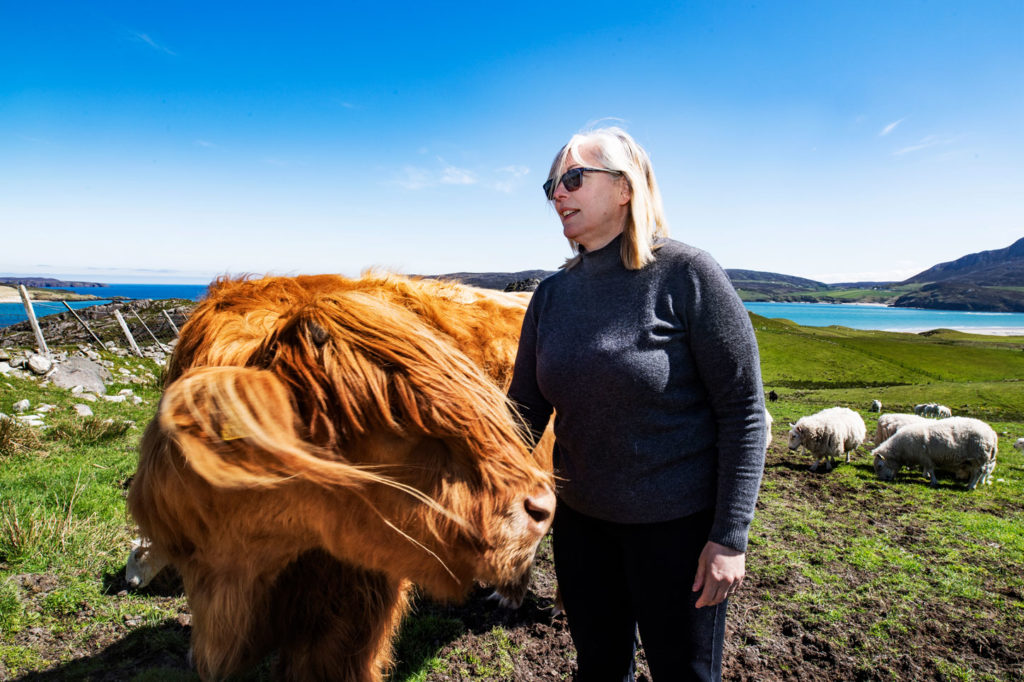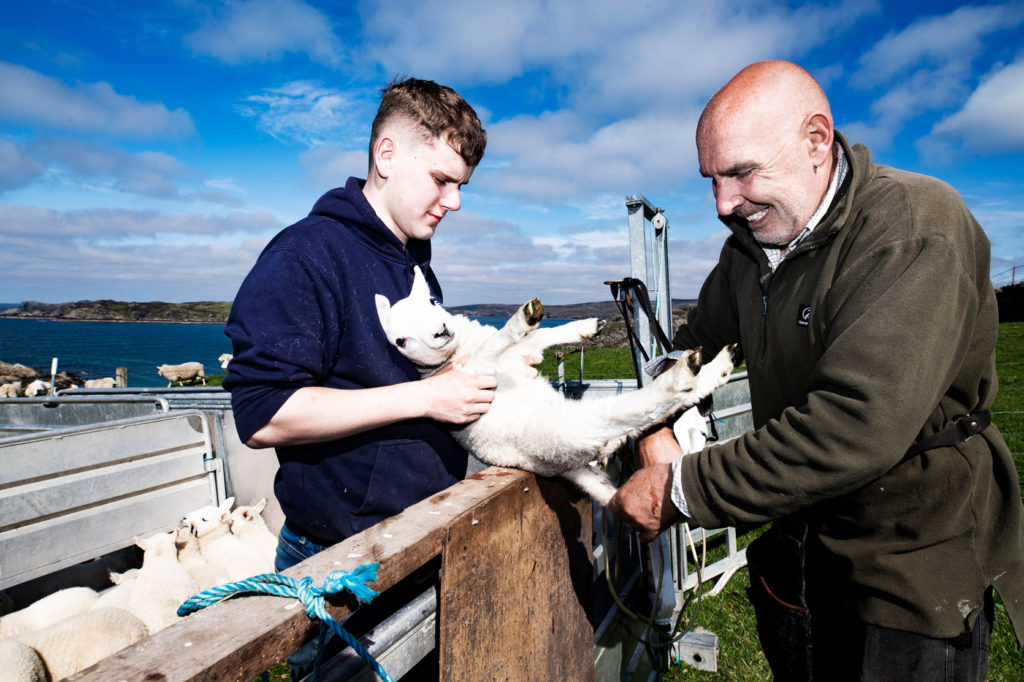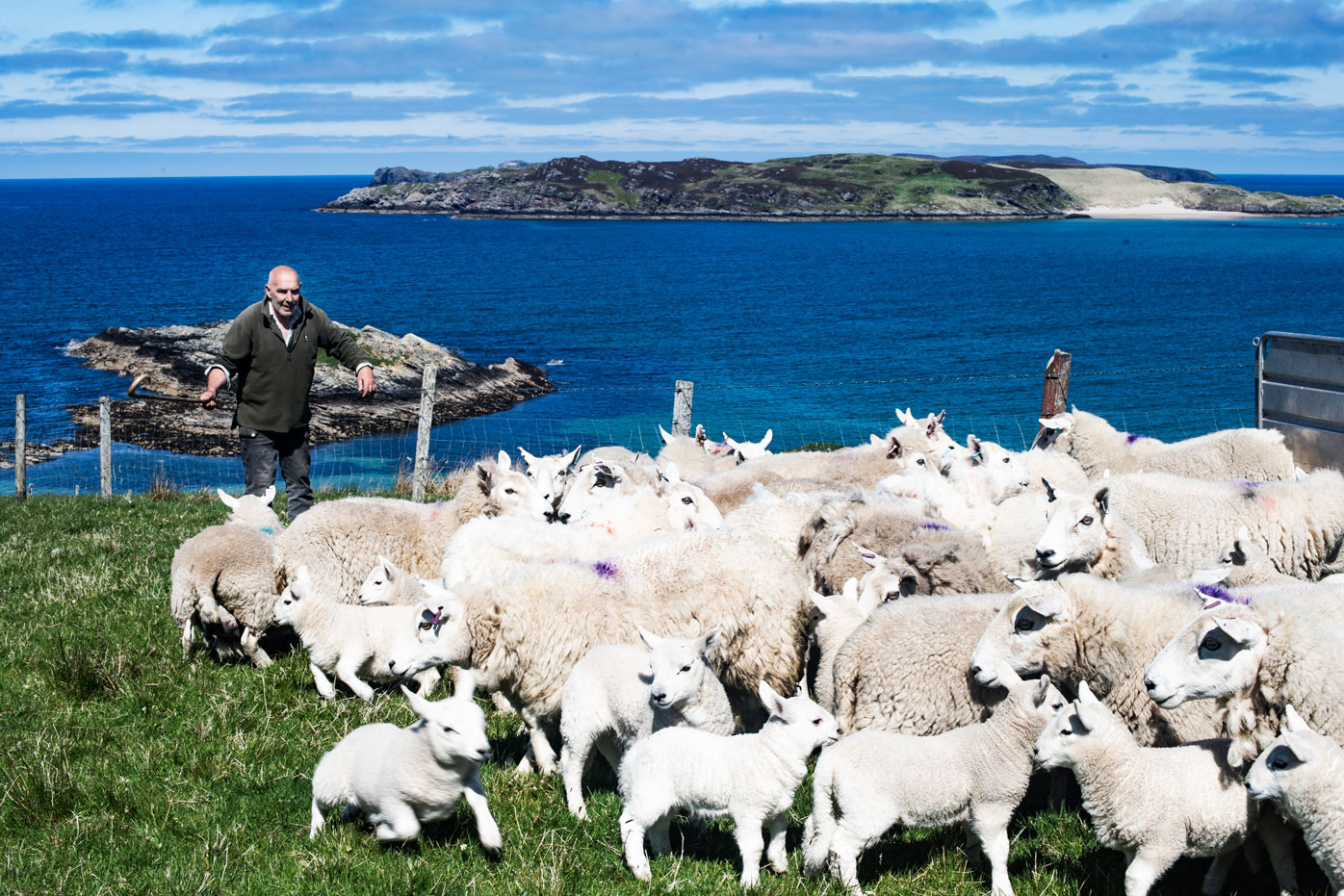Dorothy Pritchard, chair of the Melness Crofters’ Estate, points to a light strip of soil at the foot of Ben Hutig, the mountain she is facing. Behind her, the peaks of Ben Loyal and Ben Hope form a picturesque backdrop. “That’s where the launching platform will be built,” she says. “But don’t expect anything massive. It’s just a platform, and the rockets with which the satellites will be shot into orbit will only be 19 meters [62 feet] high. A needle in the landscape. You’ll hardly notice it at all.”
Visually, she means, because the community that lives here in the wide-open Scottish landscape of peat banks and mountains, where the North Sea meets the Atlantic Ocean, knows the space hub all too well for the developments it will set in motion. Jobs and affordable housing, for starters. More importantly, the expectation is that the space hub will protect the tiny villages in the area from disappearing altogether.
Turning toward the three “bens” — Gaelic for mountains — Pritchard gestures over to the peat banks and explains that peat absorbs and stores large quantities of carbon dioxide. The road on which we were standing, which had fallen into disuse, had been built on top of peat bogs, which strengthened it. “This is how we’ll construct the road to the launching platform as well. I mean, we know this land and how to use it properly.” Asked if those stretches of land belonged to the Danish billionaire Anders Holch Povlsen, including the mountains, she said no, “because the land belongs to itself.” She then added, “but legally speaking, yes.”
In the last decade, Povlsen, who earned his fortune in the retail fashion industry, has bought every estate placed on the market here in Sutherland in the north of Scotland. He owns all the land surrounding the Melness Crofters’ Estate. The latter, however, is not for sale. In the 1990s, the crofters received their estate as a gift from their late landlord, who firmly believed that the people who worked the land ought to own it. But while the crofters seek to revive their community, Povlsen is developing Wildland, an ecological rehabilitation project to rewild this part of Scotland. That’s where the two interests have clashed. In an effort to stop construction of the space hub, Povlsen filed for a court judicial review, claiming the hub would harm the nature he was trying to revive. When that failed, he tried to use the land court to stop the crofters’ project. Since Povlsen never speaks to journalists, Pritchard explained for him: “He loves nature. We love nature too, but with people in it.”
The crofters’ estate, owned by some 60 crofters, has been looking for a way to revive their community for years. Since the 1960s, coastal life has thrived, with many families’ breadwinners finding well-paid jobs at the oil platforms. When jobs in the oil industry disappeared, however, families left. Young people moved away to study in Edinburgh, Glasgow, London or elsewhere, and didn’t return to the land where they grew up because there was no way to make a living. “There used to be several schools here,” says Pritchard, “but they have all closed.”
On the main road passing through Tongue, the largest village, a building stands abandoned. Until two years ago, it was a branch of the Bank of Scotland. “Three people lost their jobs when it closed. A great loss,” Pritchard laments. “Most of the jobs now are in tourism, but those are seasonal jobs and won’t attract young couples to raise their families here. What we need is diversity.”
Because of the position of the sun relative to this region, the Highlands and Islands Enterprise (HIE), a bureau of the Scottish government that helps local communities with economic development, has determined that the north coast of Scotland is perfect for shooting commercial satellites into orbit. Launching stations are ideally located either near the equator or near the North or South Poles. A location is especially interesting if it enables satellites to be shot in a so-called sun-synchronous orbit around the Earth, which means the orbit is synchronous with the highest position of the sun in relation to the Earth. Add in its low population density and proximity to water, and the north of Scotland ticks all the desired boxes.
When the HIE first arrived, however, the crofters were skeptical, not just about the high pie-in-the-sky chatter but also — mainly — about environmental and safety concerns.
What eventually convinced them to cooperate with the HIE was the number of jobs the rocket-launching platform would create, and the prospect that this could become the “most ecological launching site on earth.” Roy Kirk, the man who initiated the project for HIE, lists the details: “Biopropane will be used for the launches instead of kerosene, reducing the carbon emissions by 96%. The rockets will fall back into the sea, from where they will be recovered for reuse. And we are building the platform at a location where we will need to remove only a small amount of peat. Peat retains CO2 very well, much better than trees. The peat we do need to remove will be used to restore peat bogs elsewhere.”
As for the jobs it will create, Kirk says: “It’s rocket science! There will be smart jobs for smart people. Apart from selling and preparing the launches and carrying them out, the rockets, which are produced elsewhere in Scotland, need to be assembled. You need a listening station to collect the data and analyze it. You need a communication person, a meteorologist, and the fire brigades need to be expanded to meet all safety requirements.”
As the crofters’ estate warmed to the idea of a rocket-launching platform on their land, they began to involve other stakeholders in the community, most importantly the Grazing Committee. The latter would only approve the plan if the land where the launching platform was going to be built would remain open to sheep grazing as much as possible, with minimal fencing. This meant tough negotiations with HIE’s Kirk, who had intended to fence off much more land than the Committee would agree to. Eventually, all parties involved came to an agreement on fences and finances.
Because their plan was solid and rooted in community approval, the crofters were not too worried when Povlsen applied for the judicial review regarding environmental damage. “We don’t want to destroy the environment either, and the space is just not going to have a big footprint at all,” explained Kirsteen Mackay, a board member of the Melness Crofters’ Estate. Had the lawyers’ bills ended up on their desks, the project would have ended instantly, but, as owner of the project, HIE carried all the extra costs. It did mean a delay of two years, however. Other communities have had to cope with Povlsen’s seemingly endless budget for court cases as well. He has also reportedly objected to two wind farms near his estates.

What makes his objections peculiar is not just that he tends to travel to his estate by helicopter, causing a lot of noise, but that he himself invested millions in a space hub on one of the Shetland Islands, off the northern Scottish coast. Perhaps he sees the community plan as competition? Pritchard shrugs off the question. “We are not competition, and I don’t know if he sees us that way. I don’t really care. We don’t interfere with his plans.”
Kirk adds, “I met him once at a conference. A powerful man, and quite pleasant really.”
The story of Melness Crofters’ Estate and the wealthy outsider trying to barge in recalls the gentrification that has come to define life in so many cities around the world. Neighborhoods where nobody wanted to live for years or even decades, and where marginalized and economically-deprived communities had created a space for themselves, suddenly attract the attention of people with money, driving up real estate prices and pushing out the original inhabitants. The crofters of Melness won’t let it happen. “One of the first things we want to do with the money we earn from the space hub is build affordable houses,” says Pritchard. “Povlsen buys pretty much every house that comes on the market, which makes it hard for people who do want to stay here to find an affordable place to live. And of course, we need good housing also for the people who will take the jobs that we create.”
The crofters thus hope not only to revive the community but also to diversify the labor market. As a result, people along the coast will become better employers with more options for themselves and better owners from whom to rent roofs over their own heads.
“We have to be careful,” says the former Scottish Parliament member Andy Wightman, “not to make a caricature of the ‘rich Danish man’ or the ‘aristocrat from London’ who buys estates. It’s us, the Scots, who make the rules. It is not the ones who act in line with the current regulations who are the problem; it is the system of laws that arranges ownership in Scotland.”
Wightman has been interested in land ownership in Scotland for decades. In 1996, he published the book “Who Owns Scotland?” Between 2016 and 2021, he was a member of parliament (MSP), first for the Scottish Green Party and later as an independent. Currently, he is updating his database, whoownsscotland.org.uk, in which Povlsen will have a prominent place. “Just as in Melness, you see that everywhere in Scotland people react pragmatically when somebody buys large stretches of land,” Wightman contends, “especially if such a person is making investments, like Povlsen. Don’t bite the hand that feeds you.” Povlsen is investing in nature, but also building a large five-star hotel, which will generate jobs. His Wildland project also provides locals with employment.
Wightman’s view is that land ownership legislation in Scotland has never been in tune with reality. “Years ago, a Scottish minister told me that the Scottish land reforms were completed. I was flabbergasted.” Until 1999, London was responsible for all legislation in Scotland, after which the newly-founded Scottish Parliament in Edinburgh took over. “London never wrote many specific laws for Scotland, so they all had to be created,” he explains. “Strangely enough, the fundamental legalities of land were hardly ever deliberated or discussed, leading to laws that basically say that local communities have the right to buy land. But that’s not necessarily what communities need or have the budget for. The result is that, in many cases, the land goes to the highest bidder.”
Limiting the number of estates or acres of land a person or company can buy is not a solution, he adds. “That is easy to circumvent. It would be better if the government intervened in the market by awarding land that is put up for sale to the bidder who wants to invest in the community and has the best plan to do that.” An inventory of a village’s or hamlet’s needs should be created that explains how much land would be required to realize those needs. Then the local planners would be ready when the land became available.
Wightman himself was enthusiastic when Povlsen first bought land in Scotland in 2006, farther south in Glenfeshie, in a national park west of Aberdeen and south of Inverness. “He wanted to reforest the land, and it wouldn’t cost us a penny. Fantastic!” Wightman recalls. “But later he moved to Sutherland in the north, where land issues are precarious.”
By “precarious,” Wightman refers to the so-called Clearances. From around 1750 to 1860, the population of the Highlands was cleared from the interior and pushed to the cities and coastal areas. The landlords had struck a deal with the government in London to clear the land of people because it was more profitable to keep sheep. Some of the rural population migrated voluntarily, but more were forced out, with violence when necessary. That was when Tongue, Melness, and all the villages along the northern coast came into being. Before the Clearances, they did not exist.
Both Mackay and Pritchard have family histories tied to the Clearances. “Somewhere in my father’s family line, my ancestors were kicked out of their houses, which were set alight after that,” said Pritchard. “I don’t know the details, but I do know my father’s family was forced to this coast at the time,” added Mackay. “I have a cousin in New Zealand who has figured it all out, but for me those details don’t matter so much. We stayed in Scotland. For us, the Clearances have become part of the fabric of our existence.”
The Highlander psyche, Mackay continued, is part of that fabric. “We are not naive; we are aware of what can happen, of how power can uproot your life. We appreciate our independence. Nobody but us can make decisions about our lives,” she said.
For anyone wishing to know more about the local history, Mackay’s husband, Allan Mackay, an amateur historian, is the person to speak to. He is also a shepherd, who serves the community by volunteering as a clerk for the Grazers Committee. In addition, he has been employed by one of the estates here for decades. Not too long ago, Povlsen bought that estate. “He inherited me as an employee,” Allan grins.
As he does routine work on a croft, looking out over the ocean, he gestures to the bay behind us. “In this bay,” he says, “a ship arrived loaded with gold for the Jacobites, but it was confiscated by the British before it reached the shore.”
In early 1746, the son of the deposed and exiled King James (Jacobus) Stuart, known as Bonnie Prince Charlie, tried to reclaim the English throne for his father. Could the ship that was supposed to unload in Tongue have turned the tide for the Jacobites? Their uprising didn’t go particularly well. Reportedly, the ship was laden with 13,000 pounds worth of gold. “According to the legend, part of that gold is in Loch Hakon,” Allan says, gesturing with his head in the direction of the lake. Three weeks later, the Jacobites’ struggle ended in the Battle of Culloden, the last battle on Great Britain’s soil.
The flock is loudly bleating. As he grabs another lamb, Allan continues: “After the uprising was crushed, London did everything in its power to prevent a new uprising. Restrictions were imposed on wearing tartans, on playing the bagpipes, on speaking Gaelic.” Soon after that, the Clearances began.

The Clearances eventually ended after the “crofters’ laws” were introduced in 1886, which gave crofters rights over the land they worked. It is those post-1999 Scottish laws, and others that later emerged from them, that protected the Melness Crofters’ Estate from the interference of Povlsen and ensured capital could never impose its will on the Highlanders again. “Povlsen’s a businessman, and that’s fine, but we used the protocols, laws and procedures that didn’t exist during the Clearances to protect our rights,” says Mackay. “We succeeded.”
The last court case was an obligatory procedure at the land court. Povlsen paid the judicial costs for a few people in the community to appeal the satellite-launching project, but the court ruled that their arguments carried no weight. As clerk of the Grazing Committee, Allan also served as a witness, arguing that the space hub had no negative effects on the shepherds’ grazing land. “The outcome was not favorable for Povlsen, my boss,” says Allan. “I had inquired whether I was obliged to stand as a witness, and I was. Povlsen understood that. He’s not a bad employer.”
Mackay is the first local who found a job connected to the space hub. She is responsible for “preparation and development” at Orbex, the company that will launch the rockets. Their office is in Forres, 100 miles away, but she mainly works from home. Now that a memorandum of understanding has been signed between Povlsen and HIE, in which Povlsen promises not to open new court cases and HIE promises a maximum of 12 launches a year for the next seven years, all the community is waiting for is the final signature from the Scottish authorities in Edinburgh. August was the target date, but it has now been delayed until later in September or October.
Pritchard doesn’t worry. Neither do her fellow crofters. “The timeline isn’t definite,” she says, “but we’re moving forward.”



